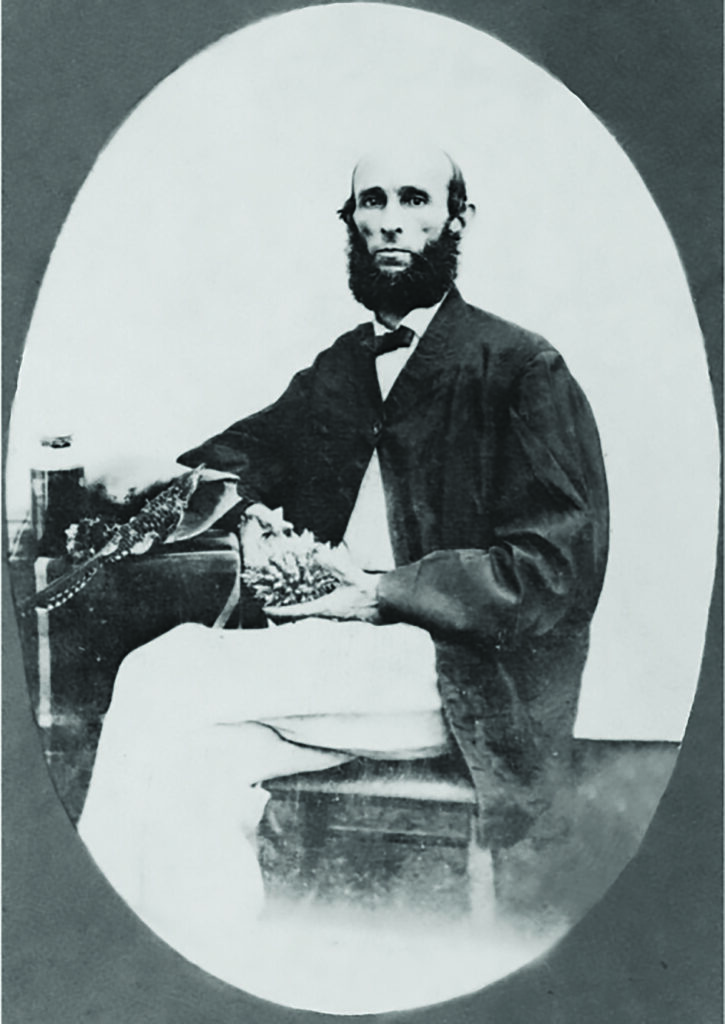
You say loricula, I say loriculus…
Excerpt from Editor’s Page,
CORAL Magazine, July/August 2022
Cannibals, he wrote, were his greatest fear when island-hopping across the tropical archipelagos of Oceania in the mid-19th century, but young Alexander Garrett also battled shipwrecks, fevers, and perpetual shortage of funds as he made the first scientific collections of mollusk shells, dried plants, bird skins, and many of the iconic reef fishes that we keep today.

Remarkably, Garrett was a self-taught naturalist from the snowy mountains of Vermont who bummed passage on wooden whaling ships to crisscross the tropical Pacific, collecting and shipping thousands of specimens to leading museums of the world to be studied and scientifically described. Thus did the great zoologist Albert Günther take note of a small fish from Polynesia in storage at the British Museum, naming it Holacanthus loriculus.

The so-called preserved “type specimen” posed some immediate challenges. Günther noted: “Mr. Garrett says of this fish that he has obtained only a single mutilated specimen, 2½ inches long, from the stomach of a Serranus off the Glesellsclafts [Society] Islands. The somewhat enlarged illustration which he gave of it shows, however, that this fish is as yet undescribed; the peculiar coloring and armament of the preorbital and preoperculum characterize it completely…”
Almost a century and half later, the Flame Angelfish graces our cover for this issue, and it is still a species that captivates us and also brings with it an ongoing controversy. Today, of course, the Flame Angelfish has been moved to the genus Centropyge and, according to Google tracking, is most often called Centropyge loricula, with 30,700 search results. In contrast, Centropyge loriculus shows 19,300 listings on the Internet. For a view from someone in the center of this taxonomic tangle, we turned to friend and world expert on the genus Centropyge, Dr. Richard Pyle, Senior Curator of Ichthyology at the Bernice Pauahi Bishop Museum in Honolulu, to help set the record straight.
“Here’s the full story on Centropyge loriculus,” says Pyle. “I was actually the first to realize that while the genus Centropyge was feminine, all of the adjective species epithets took the masculine form (e.g., flavissimus, bispinosus, etc.). According to the rules of nomenclature, if a species name that is an adjective is combined with a masculine genus (like Holacanthus), its suffix should end in ‘-us’. But if the species is combined with a feminine genus (like Centropyge), the suffix of the adjective species names should change to ‘-a’.

“Thus, for example, two species were originally named (correctly) as ‘Holacanthus flavissimus’ and ‘Holacanthus bispinosus’; but when they were changed to the genus ‘Centropyge’ (feminine), they needed to change to ‘Centropyge flavissima’ and ‘Centropyge bispinosa’. However, when that happened (in the 1930s), they didn’t realize Centropyge was feminine, so for most of the 20th century, those names were incorrectly spelled as ‘Centropyge flavissimus’ and ‘Centropyge bispinosus’. When I figured this out, I switched all the adjective species names in Centropyge to their correct spelling with the suffix ‘-a’ (as in, ‘Centropyge flavissima’ and ‘Centropyge bispinosa’).
“However, a lot of folks in the aquarium world didn’t know the actual rules, so mistakenly believed that all Centropyge species names ending in ‘-us’ should be changed to ‘-a’—including Centropyge loriculus. However, ‘loriculus’ is not an adjective, it’s a noun—and as such, the rules require that the original spelling be maintained. In this case, the original spelling was ‘loriculus’, so because it’s a noun, it retains the original spelling as ‘Centropyge loriculus’. Incidentally, another translation for ‘loricula’ is corset, and our best guess is that for some reason Günther used this name to refer to a small breastplate or corset. However, he originally combined it with the masculine genus Holacanthus, and I suspect that may be why he (mistakenly) spelled it ‘loriculus’.
“Even though Holacanthus is masculine, because loricula is a noun, Günther should have spelled it ‘loricula’. But the rules of the Code require that we stick with the original spelling, even if incorrectly Latinized. Thus ‘loriculus’ is the correct original spelling. So, that’s a long way of saying that Jack Randall and Gerry Allen are correct, and the spelling is ‘Centropyge loriculus’—and many in the aquarium community have had it wrong for all these years. I’ve explained this to people in the aquarium community dozens of times, but people still make that common mistake of spelling it ‘loricula’. Also, it’s not a matter of opinion—the rules are the rules.”
Turns out we are among the culpable, having edited “loriculus” to “loricula” hundreds of times in various books, calendars, and magazine articles. Some in our own ranks see things differently, and we will move this discussion to an online space where all comments and dissent are welcome. As another side-note, the rules say that if you can’t determine whether the species is intended to be a noun or an adjective, then you should treat it as a noun (and retain the original spelling). So, no matter what, “loriculus” is (and always will be) the correct spelling.
Amen. (At least for now.)
—James Lawrence
Shelburne, Vermont
CREDITS
R. PYLE: BISHOP MUSEUM. HOLACANTHUS LORICULUS (ILLUSTRATION): A. GARRETT / BRITISH MUSEUM. TOP: A. GARRETT / SMITHSONIAN INSTITUTION; BOTTOM: A. GÜNTHER / BRITISH MUSEUM





I deeply appreciate you for your writing the very interesting and understanding article.
Great article about my favorite fish!